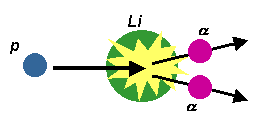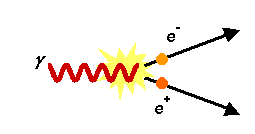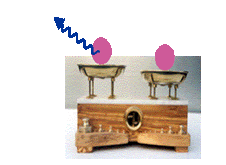



In order to test eq. (1), Einstein suggested to ‘weigh' an atom before and after it had undergone radioactive decay. The implementation of such experiment, however, was technically difficult, and the first tests followed a different strategy, involving particle collisions. When a lithium atom (Li) is bombarded with a proton (p), two a-particles emerge. A decrease in the total rest-mass is observed in this process: the rest-mass of the ensemble proton + Lithium atom is greater than the total rest-mass of the two a-particles (which can be determined independently). This is at odds with the classical principle of mass conservation.
On the other hand, there is an increase in the total kinetic energy: the kinetic energy of the proton is less than the total kinetic energy of the two a-particles. (The Lithium atom is considered at rest and does not contribute to the balance.). In another experiment, an electron-positron pair (whose rest mass is different from zero) emerges from a g ray photon (whose rest mass is zero). This is an example of how pure electromagnetic energy is converted into massive particles. Interestingly enough, for the conversion to take place, the g rays frequency must overwhelm a threshold value. To understand this fact, we first note that the energy of photons depends on their frequency according to the relation E=hn (see complementarity). On the other hand, given eq. (1) and assuming that the total mass-energy involved in the process is conserved, the energy of the g photons must be equivalent at least to the sum of the rest masses of the electron and the positron (the surplus of electromagnetic energy provides the electron-positron pair with kinetic energy, i.e., with a non-zero velocity).


